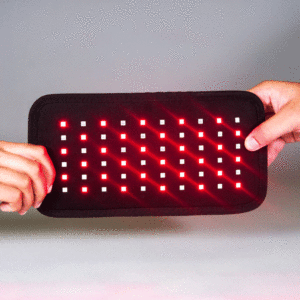How Infrared Light Therapy Helps Provide Pain Relief
It has been discovered through scientific research that red and infrared light can exert certain effects on living cells, with numerous applications for treating inflammation and wound healing. Infrared light therapy (ILT), in particular, offers pain relief benefits that work for everyone from athletes to casual exercisers or people with chronic muscle or nerve pain. If you’re looking for a non-invasive and natural form of pain relief, learn how infrared light therapy works.
Table of Contents
Infrared Light vs. Red Light
If you’re considering light therapy for pain, you’ll see different products available that have red light or infrared light or both types of light. Therefore, it’s helpful to know what makes red and infrared light therapy different.
One difference between red and infrared light is how the depth their wavelengths penetrate the body. Light appears as different colors according to its wavelength. The human eye can detect wavelengths ranging from about 400 to 700 nanometers (nm), a tiny range when you consider all forms of energy. Red light resides at the end of the spectrum with the longest visible wavelengths. Just beyond that range lies infrared light, which makes it invisible to the human eye.

Since the human eye cannot detect infrared light, on treatment devices with both red and infrared LEDs, you only see the red lights. One way to test your device’s infrared lights is with a high-speed digital camera, such as the one on your smartphone.
Given the differences in their wavelengths, red and infrared light also have separate clinical applications in LED devices. Red light works primarily on the skin’s surface, which is one reason for its popularity in beauty and anti-aging applications. Infrared light therapy penetrates deeper into the body, which is how it’s able to treat muscle and nerve pain. However, the two light sources can complement each other in treating soreness in the body at different depths of tissue.
What is the History of Infrared Light Therapy?
Infrared light therapy uses infrared waves of light emitted from LEDs to treat living deep tissue. NASA first used visible red and invisible infrared light technology in a clinical context in the 1990s. From there, scientists learned of its positive effects on other types of living tissue. Infrared waves of light penetrate far beneath the skin into the deep tissue to promote cell regeneration and increase blood flow, thus preventing cell death that causes tissue damage. The results of regular infrared light therapy treatments can include less muscle soreness, fewer spasms, and less stiffness.
Infrared light therapy devices made for home or clinical use are a more recent innovation that can deliver infrared energy to a particular area of the body where nerve pain or muscle stiffness is a problem. Infrared light treatments for home use are popular with a large audience, from athletes to those with chronic or mild pain. The results are best achieved through regular use.
How Do Infrared Light Therapy Devices Treat Pain?
What is going on beneath the surface when you use an infrared light therapy device? The light energy penetrates through multiple layers of skin to reach deep muscles and nerves. Your cells absorb energy from the light and become more active. Blood flow increases to the area as well to further support cellular regrowth and regeneration, a combination of activities that works to reduce inflammation and repair wounds or injuries.
Is There Research Showing That Infrared Light Therapy Really Works?
Infrared light for pain, and light therapy generally, are fairly new concepts in the health and wellness community. As a result, the body of research on their effects is still in its early stages. However, the body of proof showing light therapy’s efficacy is growing as interest in the technology increases. Here are some of the promising research results from the scientific community about infrared light therapy.

Back Pain Research
The journal Pain Research and Management published a study on infrared therapy for chronic low back pain that followed 40 patients over six years. Patients used wearable devices that emitted light in a wavelength range of 800-1,200nm. They reported a significant reduction in pain with no adverse effects.
Another study, published in Turkish Journal of Physical Medicine and Rehabilitation, looked at the impact of ILT on spondylitis, or inflammatory arthritis of the spine. In the study, patients treated with ILT experienced significantly improved activity, function and quality of life.
Nerve Pain Research
An article in the journal Photochemistry and Photobiology looked at infrared’s ability to stimulate nerves and support wound healing. That study concluded, “Nerve cells respond particularly well to infrared radiation.”
Other Promising Areas for Infrared Light Therapy Research
Infrared light therapy is being studied as a way to improve circulation in people with diabetes. The medical community is even looking at how it can be used in neurosurgery. With more research taking place, the use of infrared light therapy for pain will likely be refined even more. In the meantime, clinical devices for home use are widely used to treat pain symptoms.
Can Infrared Light Therapy Be Dangerous?
A common question about light therapy is how often it should be used, and whether it can be dangerous. Light therapy is occasionally referred to as “radiation therapy,” which leaves some people to believe that it carries the same risks as sun exposure. This is not the case. Radiation simply refers to any energy coming from a source—anything from a lightbulb to a radio, or in this case, an LED.
Red and infrared LEDs produce non-ionizing forms of radiation. This means red and infrared light therapy devices do not pose the same risks as UV light or X-rays. While ionizing radiation contains enough energy to affect the structure of atoms, non-ionizing radiation in LED light therapy treatments does not have that same negative effect.
*While light therapy is generally considered safe when used as directed, it’s recommended that you consult with your physician about your individual situation before starting any pain treatment regimen.
Look for FDA-Cleared Light Therapy Devices
When selecting an infrared light therapy device for pain, you increase your odds of getting safe and high-quality results by choosing a light therapy product that is FDA cleared. This designation for medical devices means that the FDA has reviewed the product and determined the manufacturer can demonstrate that it is “substantially equivalent” to another legally marketed device with FDA clearance or approval. Light therapy devices designed for medical conditions and pain management are even eligible for FSA benefits.
What Types of Pain Does Infrared Light Treat?
Infrared light therapy devices can target most areas of the body (except for the eyes). Among the most popular uses for infrared light is to treat the following conditions or symptoms:
- Neck aches and stiffness
- Shoulder soreness, such as from sitting at a computer
- Upper back, such as after a workout
- Knee pain and stiffness
- Ankle aches, including from running
- Wrist issues, including carpal tunnel syndrome
- Feet, when sore from standing, arthritis, or other causes
- Hands, when tired and achy from arthritis or other issues
Acute and chronic lower back pain, in particular, is among the most common uses for infrared light; experts estimate back pain affects 80 percent of people at some point in their lives. In such hard-to-reach places, a flexible, wrap-around light therapy device can easily target the lower back. Additionally, there are oral care LED devices that use infrared light to treat inflammation and pain of the gums.
Versatile Pain Relief The dpl® Flex Pad relaxes muscles and... The Most Versatile Joint Pain Relief Device The dpl® Joint...
Flex Pad – LED Light Therapy Muscle Pain Relief
dpl® Joint Wrap – LED Light Therapy for Joint Pain Relief
How Often Should You Use Infrared Light Therapy?
With your own infrared light therapy device, you can treat your pain once or twice a day at home, the office, or the gym. Treatment times vary from 14 to 25 minutes, depending on the device and the specific pain issue, for each area of the body. For the best results, keep track of your time while using the device in one area and then move to the next area when it’s appropriate. If you’re new to using red or infrared light therapy, it’s recommended to start with single treatments each day and monitor your results with pictures. As always, it’s recommended you first talk with your physician about new pain treatments.
Though it’s still an emerging technology, infrared light treatment is growing in use. If you suffer from muscle pain or inflammation, nerve pain, or joint stiffness, an infrared light therapy device may be able to help.
TENS/EMS Technology from a Name You Trust
If you’re reading this, you probably already know about the quality pain-relief light therapy product that dpl® has built its reputation on (and if you don’t, we welcome you to browse our selection of industry-leading devices).
Now, dpl® is bringing the same level of technical expertise and quality-first construction to this additional pain-relieving product line with our dpl® TENS/EMS Back Pain and dpl® TENS/EMS Joint Pain devices. Check them out to add another non-invasive and drug-free arrow to your pain-management quiver.

Experience the power of light therapy at home
Specific wavelengths of light have different effects, and can be used for a variety of applications — from destroying acne-causing bacteria to killing harmful germs on your phone. Our light therapy devices allow you to harness the power of LEDs in the comfort of your own home.
See How It Works











